
By: Ilaria Pasquinelli, Twitter: @ilaria78, international marketing consultant for the textile and fashion industry.
Last week I had the opportunity to speak at Sustainable Brands Istanbul about the risks and opportunities related to sustainability for textile and fashion businesses. Turkey is a key global producers of textile and garments and the export of these products account for roughly 20% of the country’s overall exports. The constant growth of the Turkish industry is certainly due to the fact that European fashion brands tend to increasingly bring back production closer to sales markets. Part of the growth is also due to the expansion of the country’s domestic consumer market.
Sustainable Brands is a growing community of marketing, sustainability and business leaders that share experiences, knowledge and best practises to ensure that business actively contributes to the creation of a sustainable future.
Sustainable Brands Istanbul made me understand how thinking around sustainability in business is converging. All the speakers’ presentations and talks had a lot in common.

Firstly, there is no doubt that business has a very important role to play in the society. More than governments, it is business that has the responsibility and the power to ensure a sustainable future. Like Dorothy Mackenzie, founder of agency Dragon Rouge said “sustainability is about deciding if you want to create the future or respond to it”. So true: we also believe that sustainability equals innovation and planning ahead of time. If sustainability is not an aspiration, surely it is has to be pursued for necessity: we are all familiar with the issues related to resource scarcity that we’ll have in few decades. Simon Mainwaring of We First said that “the future of business is purpose”. Brands without a purpose risk their own long-term existence: as Havas Media’s latest global survey shows that “if 70% of brands disappeared tomorrow, consumers would not care”. After all, people do not necessarily want more products, particularly in Western markets. As Jody Turner said, people now define what “having” means to them.
As a consequence, it is now commonly agreed that the brands of tomorrow are “beautiful”, “better”, “meaningful”. They reach this stage when they generate value that is shared with communities and, in an ideal pyramid, this corresponds to its top. This happens when every business operation, marketing campaign, product is designed taking into account sustainability besides financial, sales, revenue, profit and efficiency goals. This is the future of brands. Compliance was yesterday and risk management has still a weight today in a company’s motivation to commit to sustainability but is not enough to trigger the much needed disruptive innovations. But how do sustainable brands look like when they reach the top of the pyramid? The 5 hallmarks of Beautiful Brands according to Dragon Rouge are: Integrity, Curiosity, Elegance, Craft as in Human Touch and Prosperity.
As usual in sustainability is not so much about “why” but about “how”. I think that we should share more knowledge and insights about how businesses go about doing it, hence how they practically find solutions to their challenges. Easier said than done: yes, businesses collaborate a lot to solve common sustainability issues but they are still a bit reluctant to disclose how they do it or what business performances they achieve because of their initiatives.
Having said that, at Sustainable Brands Istanbul we had the opportunity to see how very different businesses approach sustainability. Unilever, a global conglomerate and OAT Shoes, a small sustainable designer label. Unilever, with their multi-million Sustainable Living plan are trying to prove that brands can change people’s lives and are definitely making an effort to make their way to the top of the pyramid. Their Dove campaign has the aim of re-defining how women see themselves helping them understand that they are more beautiful than they think. Also, 57% of the multinational’s global sales in generated in emerging markets giving Unilever an enormous opportunity to create shared value by making products accessible to non wealthy communities and, for example, “educating people on basic hygiene” rather than just “selling toiletries”. OAT Shoes are the popular 100% biodegradable shoes that bloom and belong to that category of highly innovative small businesses that are not ready to make compromises or accept trade offs when it comes to implementing their sustainability strategy. These businesses have a great potential to lead change and inspire bigger businesses that could scale their innovations by collaborating with them.
Finally, how do beautiful or meaningful brands get to change consumer behaviour? This is probably one of the toughest challenges. Daianna Karaian of Futerra said that a key obstacle is Habit: people need incentives to change their daily routine. We also need Social Proof to mainstream sustainable consumption and Status is also important. After all, consuming is a social activity and says a lot about us. Persuasive communication campaigns are also powerful to make sustainability desirable.
The next Sustainable Brands conference is taking place in London on November 18-19.

